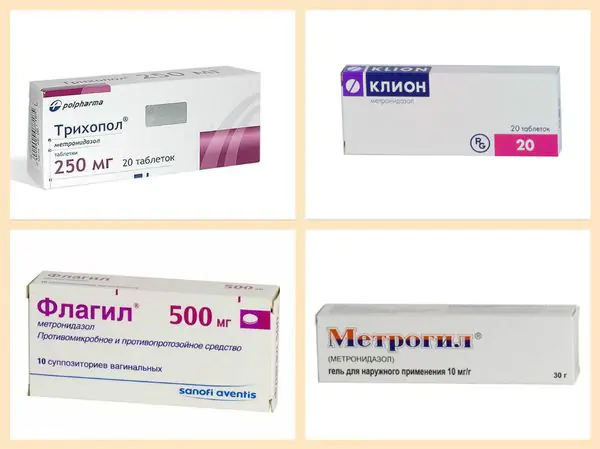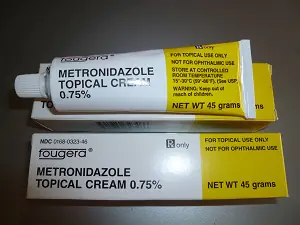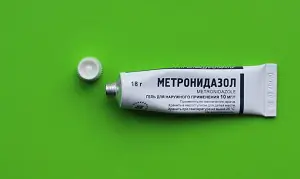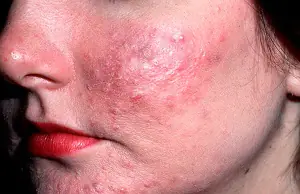Metronidazole for acne is most often prescribed for external use. Oral administration is advisable for chronic gastrointestinal pathologies (gastritis, gastric and duodenal ulcers), against which acne has occurred. Whether Metronidazole helps with acne will allow you to understand the pharmacological effect of the drug.
Composition and release forms
The medicine is available in the form of a gel, a solution for external use and in the form of tablets for oral administration. Tablets are also often used to prepare acne mash.
The main active ingredient of the drug is the active substance of the same name – metronidazole. The active ingredient has antibacterial activity.
For which acne is Metronidazole prescribed?
An antibacterial drug is used to treat acne vulgaris and rosacea.
For internal acne, which could arise against the background of chronic pathologies of the gastrointestinal tract, the drug is prescribed in combination with Amoxicillin.
Action on acne
When used externally, the drug has the following effects on damaged skin:
- dries out inflamed elements;
- reduces sebum production;
- inhibits the growth of pathogenic bacteria;
- relieves redness at the site of inflammation;
- accelerates the process of tissue regeneration.
When used internally, Metronidazole helps suppress the growth of Helicobacter pylori bacteria, which could be one of the causes of acne on the face.
Contraindications for use
Metronidazole tablets for acne should not be taken in the following cases:
- decreased level of leukocytes in the blood;
- pregnancy and breastfeeding;
- CNS lesions, including epilepsy;
- individual intolerance.
The medicine is not suitable for local use in case of hypersensitivity to the active substance. Before external use, pregnant and lactating women should first consult a doctor.
Adverse reactions
If taken orally, tablets can provoke a number of negative reactions, including:
- dyspeptic syndrome;
- pancreatitis; dizziness;
- decreased concentration;
- depressive states;
- disturbances in the functioning of the urinary organs;
- decrease in the level of leukocytes in the blood.
In the local treatment of acne on the face, the active substance can cause an allergic reaction, manifested in the form of rash, hyperemia and itching. The medicine can also cause increased dryness of the skin and irritation.
Recommendations before use
Before taking Metronidazole orally for acne, you should make sure there are no contraindications.
During the treatment period, you should not drink alcohol. The combination of the main drug and Amoxicillin is contraindicated for adolescents under 18 years of age.
Since the antibacterial component can lead to the development of leukopenia, during the entire treatment it is necessary to monitor the blood composition by taking tests.
Under no circumstances should you take the drug without a doctor’s prescription, as this can lead to serious consequences.
In case of topical use, you should first make sure that the skin is not hypersensitive to the medicine. To do this, a small test is carried out by applying the substance to a more sensitive area. These include the inner bend of the elbow and wrist. If there is no reaction after half an hour, the drug can be used for its intended purpose.
Drug interactions
Medicines from the sulfonamide group (Streptocide) enhance the antibacterial effect of the second drug. For this reason, the two drugs are often combined in the preparation of topical lotions and topicals.
Ingestion
Metronidazole against acne is taken orally, 1 tablet with meals. The daily dosage is 2 tablets. On average, the course of treatment lasts 10 days.
The dosage and duration of therapy may vary in each individual case and should be adjusted directly by the doctor.
Methods of external use
Metronidazole anti-acne gel is applied to previously cleansed skin of sebum and other contaminants. The active substance is distributed over the areas where the inflammatory process is directly localized. For extensive small acne, the ointment is applied in a thin layer to the entire face. The instructions recommend using the medicine in the morning and evening. The duration of use is determined directly by the dermatologist.
The tablets are used at home to prepare medicinal mash, masks and lotions, the recipes of which are described below.
Mask recipe
Metronidazole effectively helps against acne on the face in combination with white clay. For a heaping tablespoon of kaolin you will need a couple of crushed tablets of the second ingredient. To enhance the therapeutic effect, you can add a Streptocide tablet. Both components are mixed with a small amount of boiled water. You should get a consistency reminiscent of thick sour cream.
The finished mask is laid out in an even layer on a previously cleansed face. The exposure time should not exceed 10 minutes. After the recommended period of exposure, the remaining product is washed off with warm water. Then apply a small amount of hypoallergenic cream with a light texture and non-comedogenic formula.
Using the mask twice a week will completely get rid of rashes.
Preparing mash
Metronidazole for acne is prepared with the addition of Streptocide based on calendula tincture. The first two components have a powerful antibacterial effect and drying effect, and the third helps to more quickly relieve inflammation, eliminate redness and restore damaged tissue.
For a 40 ml bottle of tincture you will need three crushed tablets of each drug. The components are mixed, after which the medicine is ready for use. The product must be shaken before each use.
You can replace calendula tincture with salicylic alcohol, which has a keratolytic (exfoliating) effect. The medicine is prepared in a similar way.
You can also prepare a medicinal solution based on camphor alcohol. A 40 ml bottle will require half the standard of basic medicinal tablets and a couple of units of Levomycetin. Solid ingredients are thoroughly ground to a powder before mixing.
The chatterbox helps well against internal, subcutaneous, cold-related acne and other types of rashes.
Lotion composition
Half a glass of boiled water will require half a Metronidazole standard. Before mixing, the tablets are pre-crushed. Wipe your face with the resulting solution morning and evening. To enhance the antibacterial effect, you can add a couple of tablets of Streptocide or acetylsalicylic acid to the lotion. Apply until redness disappears completely.
Metronidazole analogs
Identical drugs that can also be used against acne are:

Trichopolum is available in the form of tablets and solution. For acne, it is recommended to use the first form of release. The medicine can also be used in masks, mash and lotions.
Metrogyl is produced in the form of gel, tablets and solution. To treat acne, a gel is most often used for local use.
Klion is available in tablet form and is also prepared as a solution for topical use. Can serve as an alternative in the treatment of acne, due to a similar composition.
Reviews of Metronidazole for acne
A medicine with an antibacterial effect, when used correctly, most often receives positive reviews. The drug helps to cleanse the face of inflamed elements and prevents the further appearance of rashes.
In some cases, the drug leads to side effects, both when taken orally and locally. To avoid unwanted reactions, before use you should definitely consult a dermatologist who will tell you how to properly take Metronidazole for acne in a particular case.
Non-hormonal antimicrobial and antiprotozoal drug. Application: wounds, burns, dermatitis, ulcers, hemorrhoids, varicose veins. Price from 12 rub.
Analogs: Metrogyl, Trichopolum, Rozeks, Rozamet. You can find out more about analogues, their prices, and whether they are substitutes at the end of this article.
Today we’ll talk about Metronidazole cream. What is this product and how does it affect the body? What are the indications and contraindications? How and in what doses is it used? What can be replaced?
What kind of cream is it and what does it help with?

Metronidazole cream is an effective remedy against many skin diseases. The instructions for use contain a detailed description of its medicinal properties and list diseases that can be treated with this remedy.
In the form of liniment, it is used to treat acne, acne - steroid and vulgar, rosacea, seborrhea.
Used for healing bedsores, trophic and hemorrhoidal ulcers. Also prescribed for STDs (there is a vaginal gel of the same name) in women and men.
Active ingredient and composition
Metronidazole is an antimicrobial and antiprotozoal substance. Antiprotozoal means that the product affects protozoa (amoeba, lamblia, trichomonas, toxoplasma, etc.).
Metronidazole is not a hormonal drug; it belongs to the group of imidazoles - synthetic antibacterial substances.
Contains additional components:
- methyl parahydroxybenzoate;
- propylene glycol;
- propyl parahydroxybenzoate;
- sodium hydroxide;
- carbomer;
- purified water.
Pharmacological properties

The effectiveness of the remedy is explained by its properties:
- antibacterial;
- antiprotozoal;
- regenerative;
- antiseptic.
Pharmacokinetics
Systemic absorption is minimal, with only traces of the substance found in the blood. Metabolized in the liver, excreted mainly in the urine. Penetrates into the lungs, kidneys, liver, bile, cerebrospinal fluid.
Crosses the placental barrier and is present in breast milk.
Pharmacodynamics
Refers to broad-spectrum drugs. Effective against anaerobic bacteria and protozoa:
- gardnerella;
- dysenteric amoeba;
- intestinal lamblia;
- eubacteria;
- bacteroides;
- clostridia;
- Trichomonas;
- peptococci;
- Veillonella;
- peptostreptococci;
- clostridia.
It is distinguished by its powerful resistance to Trichomonas - 9 out of 10 die on the first day of therapy. Does not affect aerobic bacteria and the causative agent of demodicosis.
It affects acne, but the mechanism is not fully understood. Destroys neutrophils, which secrete antioxidants and destroy tissue in the area with ongoing inflammatory process.
It does not treat acne, the cause of which lies in disruption of the gastrointestinal tract or hormonal imbalance.
Indications for use

The following can be treated with metronidazole:
- seborrheic dermatitis;
- oily seborrhea;
- acne of various origins;
- infectious skin lesions caused by bacteria sensitive to the active substance;
- bedsores;
- burns;
- slow-healing wounds;
- trophic ulcers (due to varicose veins or diabetes);
- hemorrhoids, anal fissures.
Metronidazole vaginal gel is prescribed to combat bacterial infections of the vagina and penis. Metronidazole cream for men is used in the treatment of candidiasis.
Gel for external use Metronidazole 1% is used in cosmetology to cleanse facial pores and treat inflammation caused by bacteria sensitive to the active substance.
Contraindications

Not prescribed for treatment:
- diseases caused by drug-resistant bacteria;
- psoriasis and other non-infectious diseases;
- demodicosis.
It is strictly prohibited in the case of:
- leukopenia (including in the past);
- CNS disorders;
- dizziness of unknown origin;
- severe liver and kidney failure;
- allergies to drug components;
- early stages of pregnancy.
Directions for use and dosage
The drug Metronidazole for external use is applied 2 times a day to clean skin. Use a strip 0.5 centimeter to 1 centimeter long at a time.
Vaginal liniment is administered using a special applicator, the volume of which is equal to a single dose (5 g). The number of injections is 2 times a day.
The duration of the course is 3, 5 and 7 days.
Use of the drug in childhood, pregnancy and breastfeeding
There are no special studies on use during pregnancy, lactation and children under 5 years of age.
Since metronidazole can cross the placenta, it is not prescribed at the beginning of pregnancy for fear of a teratogenic effect on the fetus.
The active substance is excreted in breast milk, so breastfeeding should be interrupted during treatment. Otherwise, another drug is prescribed.
Side effects
Negative actions rarely occur, and the frequency is 2 cases out of a hundred. When applied externally, manifestations from the skin, central nervous system, and digestive system are possible.
Skin (at the site of application):
- dizziness;
- paresthesia (pins and needles sensation);
- hypoesthesia (decreased sensitivity).

Digestive system:
- nausea;
- metallic taste in the mouth;
- abdominal pain (rare).
Possible side effects of vaginal gel:
- burning and irritation of the genitals of the sexual partner;
- vulvitis, characterized by itching, burning and pain;
- urinary disturbance;
- change in stool - diarrhea or constipation;
- pain in the abdomen, lower abdomen and lower back;
- decrease or increase in the number of leukocytes in the blood;
- nausea, vomiting, dry mouth.
special instructions
During the period of use of the drug, you must remember the following recommendations:
- Alcohol is prohibited during treatment. Combination with ethanol is fraught with abdominal pain, nausea, vomiting, and a rush of blood to the head.
- When treating STDs, abstain from intimate relationships.
- Simultaneous oral administration and external use require monitoring of blood counts - there is a risk of developing leukopenia.
- After discontinuation, candidiasis may develop.
- Treatment in the second half of pregnancy is carried out strictly as prescribed by the doctor and under his supervision.
- For the treatment of acne vulgaris, it is effective with oral administration of antibacterial agents.
- Cream with metronidazole for acne can dry out the skin unnecessarily; it needs to be moisturized. After application to the face, you can use cosmetics.
- Avoid contact with eyes - causes burning. In case of contamination, wash with water.
- If side effects or allergic reactions are observed, stop using the drug.
Overdose

With intravaginal and external use, an overdose is unlikely.
Drug interactions
Disulfiram and metronidazole simultaneously increase each other's side effects on the central nervous system. The interval between the use of these products should be at least two weeks.
- Incompatible with ethanol.
- Increases the concentration of lithium during simultaneous treatment with lithium preparations.
- Barbiturates increase side effects.
Analogs
Metronidazole-based ointments:
The difference between the drugs is in the additional components. Their effects on the body and other indicators are similar. Metronidazole does its job well at an affordable price.
Need to remember
Metronidazole is not a hormonal substance. This is an antiseptic antimicrobial remedy. Particularly effective in the fight against Trichomonas.
The gel for external and vaginal use is produced on a water-free, fat-free basis and does not leave a greasy residue.
Drug interactions are insignificant due to the low absorption of the active substance.
An overdose with intravaginal administration is impossible; with external application, its likelihood is extremely low.
Video: Metronidazole for acne
Every person wants their skin to look perfect. The resulting pimples cause psychological discomfort and cause many complexes. Teenagers are especially prone to developing acne.
How to cope with this problem using the drug Metronidazole in the form of tablets, ointments or mash? Can unpleasant consequences occur if the medicine is used incorrectly?
Release form and composition
Metronidazole is available in several forms: tablets, ointment, injection solution and ointment. Each of them has the same active ingredient, but has differences among the excipients. Let's consider each form of the drug separately.
Pills
The main active ingredient is metronidazole, a derivative of 5-ntroimidazole. are available in one concentration of 250 mg, the tablets are round in shape, yellowish-green in color.
Additional components include potato starch, cellulose and calcium stearate. Packed in aluminum foil blisters of 10 pieces.
Gel for external use with 1% metronidazole content. Auxiliary components - sodium hydroxide, propylene glycol, carbopol, water, etc.
Available in 18 g aluminum tubes. Produced under the name “Metrogil”, it is often used to treat dental diseases.
Injection
The main active ingredient is metronidazole at a concentration of 500 mg. Excipients: sodium chloride and water for injection. Available in 100 ml medical glass bottles.
The composition and release form are similar to Metronidazole gel.
Properties and effects on the skin
Metronidazole for acne has the following properties:
- antiporozoal;
- antimicrobial;
- Trichomonas;
- antiulcer.
The active component of the drug tends to disrupt the respiratory function of pathogenic microorganisms, which leads to their death. The medicine helps get rid of acne on the face, which is caused by the presence of harmful bacteria.
Advantages
This drug has a number of advantages over others:
- Speed of impact on the body. When using tablets, the action time increases slightly, so it is more advisable to use the external form of Metronidazole (gel or cream).
- It has a powerful inflammatory effect, so the patient will not need to take additional medications.
- No acne marks after treatment. Many patients face the problem of post-acne. It appears as small scars or cicatricial formations in the area where the pimple used to be. When using Metronidazole for acne, this problem does not exist. The patient will not need to use any other means to treat post-acne.
- Convenience and ease of use.
- Low price.
Flaws
Despite all its positive aspects, Metronidazole has huge disadvantages. These include a wide list of contraindications and side effects that may occur during treatment.
If you self-medicate, you can only aggravate the existing problem. For example, if the dose or form of the drug is incorrectly selected, it can provoke even more acne.
Analogs
The most popular analogue of Metronidazole is Trichopolum. It is prescribed in the same dosage, but the effectiveness is much higher.
Among other similar drugs, Trichosept, Metrod, Makrimiror, etc. should be highlighted. The decision to change the main medication is made exclusively by the attending physician.
Instructions for use of Metronidazole for acne
Many patients wonder how to take this drug? It all depends on the form of release and the severity of the disease.
General instructions
Treatment of acne with Metronidazole in tablet form is carried out in severe forms of the disease. Tablets are often prescribed for repeated relapses or subcutaneous acne.
The exact dose and duration of use can only be determined by the attending physician. According to the instructions for the drug, it is recommended to take 1 tablet twice a day.
The average course of treatment is 5-10 days; if necessary, the doctor may prescribe repeated doses of the drug with a break of 1 month.
Oatmeal for acne. More details here.
Mask
The external form is used very often, as it has fewer contraindications and side effects compared to tablets.
To prepare a mask based on Metronidazole, you will need to take white clay and 2 tablets (they must be ground into a fine powder).
Add a little clean water and mix well; the consistency of the mask should resemble thick sour cream. Next, you need to thoroughly cleanse the skin and apply the mask in a thin layer for 10-15 minutes. After this time, rinse thoroughly with running water.
You can increase the effectiveness of a mask with Metronidazole by using the antibiotic Levomycetin. To do this, you need to take 3 tablets of each product, crush them well and add 20 ml of calendula tincture.
This mixture should be applied exclusively to the affected areas (locally). To relieve skin irritation, you can use a soothing cream.
Chatterbox
This product can be prepared using ethyl alcohol or plain water. You will need crushed Metronidazole tablets and 250 ml of 70% alcohol or water.
All this is well re-painted and used in the form of rubbing. It should be noted that alcohol will additionally dry out the skin, so you should not get too carried away with this product.
Another option for preparing mash is the following: 4 tablets of crushed Metronidazole and Levomycetin are poured into 250 ml of salicylic alcohol. You can also use streptocide and mumiyo to prepare such a product.
Lotion
The use of Metronidazole-based lotion for the treatment of acne shows high effectiveness. To prepare it you will need 5 crushed tablets of the drug and 150 ml of warm boiled water. The resulting solution is wiped over the affected areas of the skin at least twice a day.
Video: How to get rid of rashes
Contraindications
Metrogyl gel has the fewest contraindications. It is not prescribed in case of hypersensitivity to the components of the drug, pregnancy or breastfeeding.
But the tablets have a serious list of prohibitions for use:
- leukopenia;
- diseases of the central nervous system, including epileptic seizures;
- liver disease (in this case it is necessary to adjust the dosage).
Patients with impaired renal function should not take this drug, as this may cause serious complications.
Side effects
If the recommended dose is exceeded, the patient may experience nausea, vomiting, and allergies. Under no circumstances should such signs be ignored.
At the first unpleasant symptoms, you should stop taking Metronidazole and consult a doctor.
Features of using the gel
The safest form for treating acne is Metrogyl gel. It must be applied to cleansed and dry skin in a thin layer.
In this case, the medicine should be applied to the skin first and only then cosmetics. It is not recommended to wash your face during the day after applying the gel. The average course of treatment is about 4 months, the effect is noticeable 21 days after the start of treatment.
Another advantage of the gel is the ability to use it not only on the face, but also on other areas of the body that are prone to acne.
Patient reviews of the drug Metronidazole vary: some consider it an effective and inexpensive remedy that has a wide spectrum of action.
Negative reviews are mainly caused by improper use of the medicine (non-compliance with the frequency and dosage of administration or an incorrectly selected form).
In such cases, patients complained of side effects in the form of nausea and vomiting; in some, acne began to progress even more.
Therefore, it is very important that the drug is prescribed exclusively by the attending physician; only in this case can unpleasant consequences be avoided.
Photo: Before and after
About panthenol for acne. Find out further.
Which green concealer to use for acne? The answer is here.
The safest is the use of external forms of this drug (lotions, mash, masks, gel). Treatment must be carried out under the supervision of a specialist.



